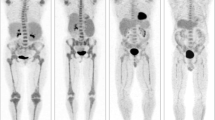Abstract
Objective
To assess the prevalence, imaging appearance, and clinical significance, of bone marrow MR signal changes in a group of human immunodeficiency virus (HIV)-infected patients with lipodystrophy syndrome.
Materials and methods
Twenty-eight HIV-infected patients with lipodystrophy syndrome treated with highly active antiretroviral therapy, and 12 HIV-negative controls underwent MRI of the legs. Whole-body MRI, SPECT/CT, and a complete radiographic skeletal survey were obtained in subjects with signal changes in bone marrow. MRI and clinical evaluations were reviewed 6 months after baseline to determine changes after switching from thymidine analogs (TA) to tenofovir-DF (TDF). MRI results correlated with clinical parameters.
Results
We observed foci of a serous-like pattern (low signal and no enhancement on T1-weighted, high signal on T2-weighted images) in 4 out of 28 patients (14.3%) and an intermediate signal on T1-weighted images in 4 out of 28 patients (14.3%). Serous-like lesions were located in the lower limbs and scattered in the talus, calcaneus, femurs, and humeral bones; they showed slight uptake on SPECT bone scans and were normal on CT and radiographs. Patients with serous-like lesions had significantly lower peripheral and total fat at baseline than other groups (P < 0.05). No changes at 6 months were observed on MRI, and the serous-like lesion group showed good peripheral fat recovery after changing drug treatment.
Conclusion
A serous-like MRI pattern is observed in the peripheral skeletons of HIV-infected patients with lipodystrophy, which correlates with peripheral lipoatrophy, and should not be misdiagnosed as malignant or infectious diseases. Although the MR lesions did not improve after switching the treatment, there was evidence of lipoatrophy recovery.




Similar content being viewed by others
References
Milinkovic A, Martinez E. Current perspectives on HIV-associated lipodystrophy syndrome. J Antimicrob Chemother. 2005;56(1):6–9.
Carr A, Emery S, Law M, et al. An objective case definition of lipodystrophy in HIV-infected adults: a case-control study. Lancet. 2003;361:726–35.
Mulkern RV, Huang J, Vajapeyam S, Packard AB, Oshio K, Grinspoon S. Fat fractions and spectral T2 values in vertebral bone marrow in HIV- and non-HIV-infected men: a 1H spectroscopic imaging study. Magn Reson Med. 2004;52:552–8.
Wiercinska-Drapalo, Jaroszewicz J, Tarasow E, Siergiejczyk L, Prokopowicz D. The possible association between serum cholesterol concentration and decreased bone mineral density as well as intravertebral marrow fat in HIV-1 infected patients. Infection. 2007;35:46–8.
Huang JS, Mulkern RV, Grinspoon S. Reduced intravertebral bone marrow fat in HIV-infected men. AIDS. 2002;16:1265–9.
Vande Berg BC, Malghem J, Lecouvet FE, Lambert M, Maldague BE. Distribution of serous-like bone marrow changes in the lower limbs of patients with anorexia nervosa: predominant involvement of the distal extremities. AJR Am J Roentgenol. 1996;166:621–5.
Vande Berg BC, Malghem J, Devuyst O, Maldague BE, Lambert MJ. Anorexia nervosa: correlation between MR appearance of bone marrow and severity of disease. Radiology. 1994;193:859–64.
Hoeffner EG, Ryan JR, Qureshi F, Soulen RL. Magnetic resonance imaging of massive bone allografts with histologic correlation. Skeletal Radiol. 1996;25:165–70.
Amano Y, Kumazaki T. Case report: Serous atrophy of bone marrow and subcutaneous tissue enhancement associated with recurrent rectal carcinoma: MR appearances. Comput Med Imaging Graph. 1996;20(3):183–5.
Hwang S, Lefkowitz R, Landa J, et al. Local changes in bone marrow at MRI after treatment of extremity soft tissue sarcoma. Skeletal Radiol. 2009;38:11–9.
Böhm J. Gelatinous transformation of the bone marrow. The spectrum of underlying diseases. Am J Surg Pathol. 2000;24(1):56–65.
Stroup JS, Stephens JR, Baker DL. Gelatinous bone marrow in an HIV-positive patient. Proc (Baylor Univ Med Cent). 2007;20(3):254–6.
Vande Berg BC, Malghem J, Lecouvet FE, Maldague B. Classification and detection of bone marrow lesions with magnetic resonance imaging. Skeletal Radiol. 1998;27:529–45.
Restrepo CS, Lemos DF, Gordillo H, et al. Imaging findings in musculoskeletal complications of AIDS. Radiographics. 2004;24:1029–49.
Tehranzadeh J, Ter-Oganesyan RR, Steinbach LS. Musculoskeletal disorders associated with HIV infection and AIDS. II. Non-infectious musculoskeletal conditions. Skeletal Radiol. 2004;33:311–20.
Janssens AM, Offner FC, Van Hove WZ. Bone marrow necrosis. Cancer. 2000;88(8):1769–80.
Weissman DE, Negendank WG, Al-Katibb AM, Smith MR. Bone marrow necrosis in lymphoma studied by MRI. Am J Hematol. 1992;40:42–6.
Tang YM, Jeavons S, Stuckey S, Middleton H, Gill D. MRI features of bone marrow necrosis. AJR Am J Roentgenol. 2007;188:509–14.
O’Malley DP, Sen J, Juliar BE, Orazy A. Evaluation of stroma in human immunodeficiency virus/acquired immunodeficiency syndrome-affected bone marrows and correlation with CD4 counts. Arch Pathol Lab Med. 2005;129:1137–40.
Lasalle S, Cervera P, Hofman V, Mari M, Dellamonica P, Hoffman P. Antiretroviral treatments-related lipodystrophy syndrome: clinico-pathological findings. Ann Pathol. 2005;25(4):309–17.
Acknowledgments
The authors thank Rob Camp, Jennifer Brickman, and Santiago Sotés for assistance with the manuscript and MRI studies.
Conflict of interest
The authors declare that they have no conflict of interest.
Author information
Authors and Affiliations
Corresponding author
Rights and permissions
About this article
Cite this article
García, A.I., Milinkovic, A., Tomás, X. et al. MRI signal changes of the bone marrow in HIV-infected patients with lipodystrophy: correlation with clinical parameters. Skeletal Radiol 40, 1295–1301 (2011). https://doi.org/10.1007/s00256-011-1147-x
Received:
Revised:
Accepted:
Published:
Issue Date:
DOI: https://doi.org/10.1007/s00256-011-1147-x




